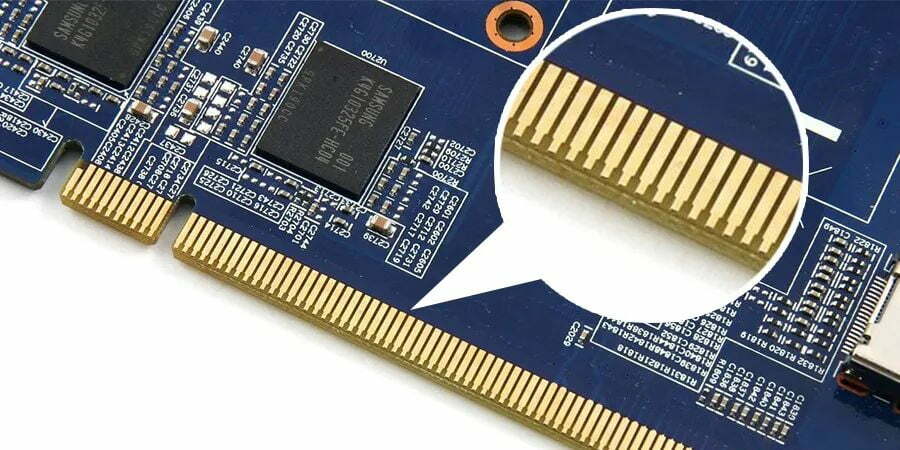In today's highly interconnected digital landscape, efficient communication between various electronic devices is essential for seamless operations. At the heart of this technological advancement lies a critical component known as the gold fingers. These gold-plated connectors play a pivotal role in facilitating communication between different circuit boards, enabling the intricate workings of computer systems and beyond.
Gold fingers are specialized gold-plated columns located along the edges of printed circuit boards (PCBs). These connectors serve as a bridge between secondary PCBs and the main motherboard of a computer or other digital devices. Their importance stems from the unique properties of gold, such as its exceptional conductivity, which makes it an ideal material for ensuring reliable signal transmission.

2 primary types of gold plating for PCB gold fingers
There are two primary types of gold plating used for PCB gold fingers:
Electroless Nickel Immersion Gold (ENIG):
This gold plating method offers cost-effectiveness and solderability. However, its thin and soft composition (typically 2-5 microns thick) makes it less suitable for frequent circuit board insertion and removal.
Electroplated Hard Gold:
This type of gold plating provides robustness and durability with a thicker layer (typically 30 microns thick), making it ideal for withstanding the wear and tear associated with repeated PCB usage.
Gold fingers' role
Gold fingers enable various circuit boards to exchange signals, ensuring that commands from users or automated systems are effectively conveyed. For instance, when a command is initiated on a mobile device, the signal traverses through multiple circuit boards before reaching its intended destination. This intricate process involves meticulous plating steps to ensure error-free signal transmission. Stringent inspection and testing procedures verify the proper alignment and functionality of gold fingers on each PCB.
The role of gold fingers extends beyond consumer electronics into industrial sectors like manufacturing. Computerized machinery in factories relies on these connectors to orchestrate a wide array of processes, enhancing efficiency and precision. For example, in auto-assembly lines or food-packaging plants, gold finger-equipped circuit boards enable the seamless execution of commands by computer-controlled machinery.
Gold fingers are employed in various ways
Interconnection Points:
Gold fingers facilitate communication between secondary PCBs and the main motherboard through slots like PCI, ISA, or AGP. These connectors enable signals to flow between peripheral devices, internal cards, and the computer itself.
Special Adapters:
Gold fingers allow for the incorporation of performance-enhancing components, such as graphics and sound cards, into personal computers. These cards, connected via gold fingers, deliver improved functionality, and can be upgraded over time.
External Connections:
Peripheral devices like speakers, scanners, and monitors connect to the motherboard through PCB gold fingers, enabling external devices to interact with the computer.
Gold fingers' versatility and durability enable them to withstand frequent usage, making them a cornerstone of modern computing. Their strategic placement and standardized design principles ensure proper functioning and compatibility. The use of gold for plating these connectors is rooted in its superior electrical conductivity and resistance to corrosion. Gold's strength and wear resistance are enhanced through alloying with metals like nickel or cobalt.
IPC Production Standards for PCB Gold Fingers
The Association Connecting Electronics Industries (IPC) established production standards for PCB gold fingers, ensuring consistent quality and performance. Adherence to these standards, such as specific plating thicknesses and testing protocols, guarantees reliable signal transmission and robust connections.
The Association Connecting Electronics Industries (IPC) established the production standards for PCB gold fingers in 2002. Subsequent refinements were made in 2012 with the introduction of IPC-4556, followed by further updates in 2015 through IPC A-600 and IPC-6010. These latter standards have become widely embraced in the realm of PCB production. The IPC standards encompass the following key aspects:
Chemical Composition:
To enhance the structural integrity of PCB contacts, optimal gold plating should encompass a cobalt composition ranging from 5 to 10 percent.
Thickness:
The gold plating thickness for gold fingers must consistently fall within the range of 2 to 50 microinches. Standard thicknesses based on size include 0.031 inches, 0.062 inches, 0.093 inches, and 0.125 inches. Thinner thicknesses are generally employed for prototype applications, whereas thicker plating is suitable for frequently engaged connecting edges.
Visual Examination:
Gold fingers are subject to meticulous visual scrutiny using magnification. The edges should exhibit a sleek and unblemished surface, devoid of excessive plating or the presence of nickel.
Tape Adhesion Test:
To evaluate the adhesion strength of the gold plating in conjunction with the contacts, the IPC recommends a tape test. This involves applying a strip of tape along the contact edges, subsequently removing the tape, and inspecting it for any indications of plating residue. The presence of gold plating on the tape signifies inadequate adhesion between the plating and the contacts.
Numerous additional standards govern the entire process of PCB gold finger plating, necessitating a comprehensive review for a thorough comprehension. As technological advancements continue, new testing standards are regularly introduced to enhance the process. It is prudent to periodically consult the IPC for updates and refinements in these standards.
In essence, gold fingers are essential components that empower modern technology by facilitating seamless communication between various circuit boards. Their impact spans from personal computers to industrial automation, enabling the sophisticated processes that define our digital world.
Trust
SprintPCB to let your creativity shine on the world stage. Our professional team will go above and beyond to meet your PCB needs and ensure your design stands out in terms of quality and performance. Whether you are an electronics manufacturer, engineer, or maker, we tailor the best solutions for you. Visit our official website to embark on a new chapter of your design journey!

